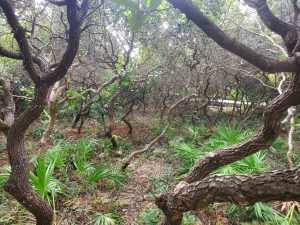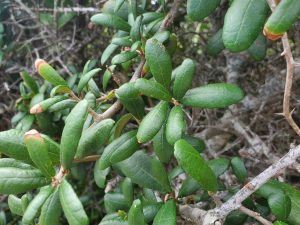Talking about a live oak might bring to mind pictures of grand, old, stately trees, limbs dripping with Spanish moss. The Southern live oak is a staple of the coastal south, but it prefers to live inland from our beaches. It leaves the salt-sprayed beach sand to its cousin, the sand live oak.
Sand live oak can potentially grow as tall as its relative, but is rarely seen reaching such heights. Growing on beach dunes, it is constantly pruned back by the wind and sometimes remains as a low shrub. When given some relief from the elements, it will happily grow taller.
Its scientific name, Quercus geminata, comes from latin, meaning ‘twinned‘. This refers to its acorns, which are typically borne in pairs. The tree’s leaves are tough, leathery, and relatively small, with the edges curled downward. The bottoms of the leaves are gray to whitish, often with a fuzzy texture to them. While the sand live oak stays green all year, it does drop its leaves in the spring and immediately replaces them. It often grows in clusters, sometimes due to its ability to regenerate from its roots after a fire. This can lead to groves of wavy, leaning trunks that spread out widely, each reaching for its own patch of sunlight.
Very little seems to harm a sand live oak. They are sturdy in intense wind, able to withstand extreme drought, tolerant of salt spray, and do not mind intense sun and blazing hot temperatures. They are usually pest and disease free, though overwatering can damage their roots and cause dieback in the above ground parts.
Potential drawbacks of this species include their copious pollen production, and their tendency to stain surfaces with their tannin-rich leaves and acorns. In all, however, they are incredibly hardy and beautiful trees when planted in their native habitat. They require little to no maintenance and offer benefits to wildlife, who will snack on their acorns. For a shade tree near the beach, make sure to put the sand live oak at the top of your list.
Evan Anderson
Walton County Horticulture Agent
- Quercus Geminata, the Sand Live Oak - November 20, 2025
- Snakes of the Panhandle - October 10, 2025
- Ganoderma, a Deadly Disease of Palms - September 4, 2025



